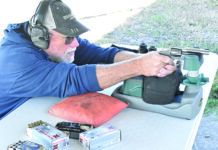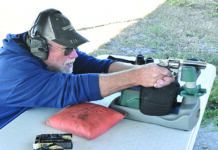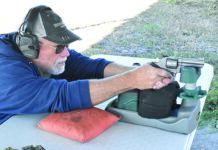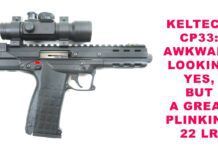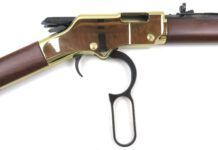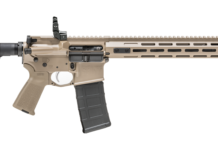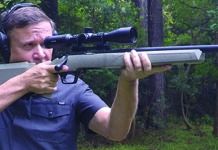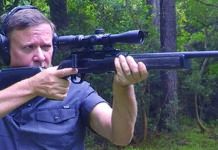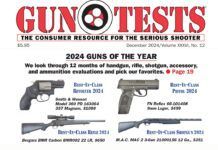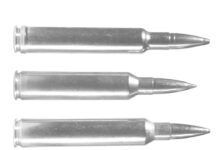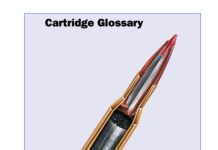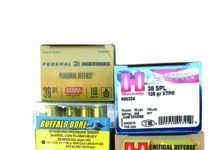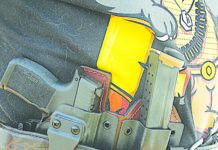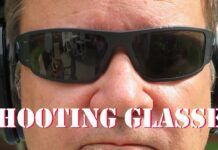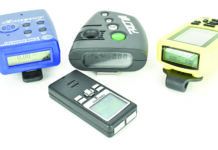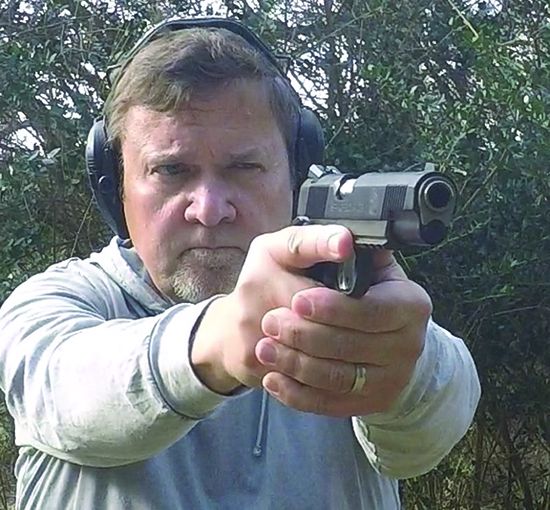Back in the late 1980s when the U.S. military retired the 1911 for the Beretta M9, the Marine Expeditionary Unit (Special Operations Capable), or MEUSOC, decided to stick with the 45 Auto 1911 platform because it was the only pistol at the time that could stand up to the use the MEUSOC teams doled out. The MEUSOC guys detailed the new features and specifications they wanted on their modernized version of the 1911, and the armorers at Quantico built the guns. Most of these guns were built on original, used M1911A1 G.I. frames. The remaining parts for the builds were a precise list that transformed the G.I. 1911s into modern combat handguns. MEUSOC operators provided feedback to the armorers on the guns, and there were four variations of these guns built. Some of the parts used in the builds reads like a who’s who of custom gun-builder pieces. Parts included Clark or Wilson Combat beavertail grip safeties, Pachmayr Gripper grips, MGW commander hammers, Videcki steel triggers, Bar-Sto barrels, Springfield Armory slides, Ed Brown safeties, Caspian mainspring housings, and more, all the way down to the smaller pins, the sear, and other parts. Common to all MEUSOC pistols were fixed sights, long triggers, G.I.-style muzzle bushings, and flat mainspring housings.
Some 1911 manufacturers produce pistols in the MEUSOC style, and we wanted to take a look at these guns. These newly-made MEUSOC 1911s are not exact copies of the Quantico builds. For example, the original specs called for a lanyard loop, which have no real use on modern commercial guns, other than impeding a magazine reload with a G.I. bump-pad-less mag. The three pistols we chose for this match up include the Military Armament Corporation (MAC) 1911 JSOC 45, the Springfield Armory 1911 Loaded Marine Corps Operator, and Rock Island Armory’s 1911 A1 Tact Standard FS. All three of these share a full-size frame, are chambered in 45 Auto, and feed from a single-stack magazine. From there, the interpretation of the MEUSOC guns takes some creative license, which is fine by us as long as it works, and we can say all three of these guns performed exceptionally well, with excellent accuracy, decent triggers, user-friendly sights, and texture where you need it on a 45 Auto 1911. If you are looking for a full-size 1911, any one of the these guns will fit the bill, but our shooters expressed some preferences that made one gun our pick over the others.
How We Tested
We shot for accuracy at 25 yards using a rest, and we moved in to 7 yards for the speed-shooting portion, where we ran a modified Bill Drill by firing as fast as we could into an 8-inch circle and performing reloads. We loaded different round counts into all the pistols’ magazines as well as using new Never Unarmed eight-round 1911 magazines ($18; NeverUnarmed.com). These steel-body magazines feature a polymer follower and bumper pad and look a lot like Wilson Combat magazines, except they are a fraction of the price. We tested for slide lock back and the ability to quickly load. The Never Unarmed magazines worked well, and for the price, we rate them a Best Buy. Slide lock back was positive with all three pistols, and the magazines inserted smoothly and clicked positively in place when seated and dropped free from the pistol when the magazine catch was pressed. We fired the pistol with and without shooting gloves. The trigger guard is not that big on 1911s, though we were able to easily use a variety of shooting gloves. All the magazines were compatible, except the Armscor mag, which couldn’t be inserted into the MAC because the bumper pad was not compatible with the MAC’s mag well.
Test ammunition was an assortment of defense and training loads. Armscor 230-grain FMJ ball ammo is similar to G.I.-style ammo and is a good choice for training. For defense loads, we used Hornady Critical Duty 45 Auto +P with a 220-grain FlexLock bullet and Winchester Silver Tips with 185-grain JHPs. If you are going to run a steady diet of +P ammo, we recommend installing a Wilson Combat Shok-Buff ($6.95; WilsonCombat.com) to protect the slide from battering the frame. You can use them with any ammo type and they last about 1,000 rounds before needing replacement. Shok-Buffs are for 5-inch-barrel 1911s only. There is not enough room for them in Commander and compact-size 1911s.
Average accuracy across the three ammo choices ranged from 2.43 inches for the RIA to 2.73 inches for the MAC. The Springfield was just behind the RIA with 2.46-inch average accuracy.
The heft of these pistols makes them easier to shoot faster. Speed-shooting groups measured 1.6 inches on average for the RIA, and 2.2 and 2.6 inches for the Springfield and MAC, respectively. In the speed-shooting section we didn’t count flyers; rather, we looked at the concentration of the holes or in some cases, one massive ragged hole.
We had two failure-to-feed jams with the MAC, and we attributed this to the 1911 being new and not having enough lube on the barrel. We sprayed Hoppe’s Gun Medic on the barrel without field-stripping the gun, and the MAC ran fine from that point forward.
Springfield Armory 1911 Loaded
Marine Corps Operator PX9105MLCA18 45 Auto
$1380
Gun Tests grade: A-
The Marine checked a lot of the MEUSOC boxes. It was accurate with a good trigger and decent sights. Not sure why Springfield ships the Marine with G.I.-style magazines when MEUSOC guns were shipped with Wilson Combat magazines.
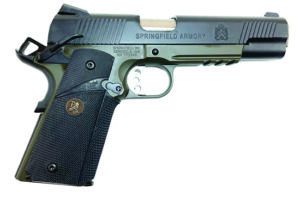
| Action | Locked breech, single-action semi-auto |
| Overall Length | 8.5 in. |
| Overall Height | 5.5 in. |
| Maximum Width | 1.4 in. |
| Weight Unloaded | 43.0 oz. |
| Weight Loaded | 49.6 oz. |
| Barrel | 5.0 in. |
| Capacity (Single Stack) | 7+1 |
| Slide | Steel, Cerakote finish |
| Slide Retraction Effort | 18.0 lbs. |
| Frame | Steel, Cerakote finish |
| Frame Front Strap Height | 2.7 in. |
| Frame Back Strap Height | 3.0 in. |
| Grips | Pachmayr Wrap Around, checkered rubber |
| Grip Thickness (Maximum) | 1.3 in. |
| Grip Circumference (Maximum) | 5.7 in. |
| Front Sight | Fixed post, single white dot |
| Rear Sight | Fixed notch, two white dots |
| Trigger Pull Weight | 5.6 lbs. |
| Trigger Span | 2.8 in. |
| Magazines | 2; steel |
| Safety | Manual thumb, beavertail grip |
| Warranty | Lifetime |
| Made In | U.S. |
| Website | Springfield-Armory.com |
The Springfield 1911 is perhaps the closest to later variations of the MEUSOC pistols and close to the MARSOC gun Colt built for the Marines in 2012, the M45A1 CQBP. The Marine looks like a modern 1911 with the rail, no-snag sights, and front and rear angled slide serrations. It is part of Springfield’s Loaded line, which juices up the 1911 platform with features like a match barrel, front slide serrations, nice extended beavertail safety, night sights, ambi safety, and crisp trigger. The Pachmayr wraparound rubber grip gives the gun that MEUSOC look.
The slide wears a matte-black Cerakote finish with three-dot tritium night sights dovetailed into the slide. Serrations offer a good grasp to rack the slide or do a press check. The slide has a ball-end cut that blends nicely with the frame. This type of detail is usually found on more expensive 1911s, and not surprisingly, the Marine is the most expensive gun in the match up.
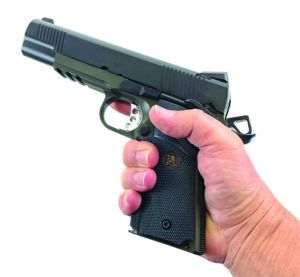
The Marine uses a G.I.-style muzzle bushing. The frame/receiver has an OD-green Cerakote finish. We liked the two-tone color scheme. The mainspring housing is checkered, and the Pachmayr grip wraps around the front grip strap, giving it that rubbery sticky texture. It also increases the grip girth slightly.
The beavertail has a high memory bump so you can be sure the safety will be disconnected when you grasp the pistol to fire. The ambidextrous thumb safety clicks on and off with a sweep of your thumb. The three-hole aluminum trigger is serrated and has about a 1⁄8-inch makeup before you hit the wall, then a crisp 5.6-pound trigger pull. Reset is about 1⁄8 inch. We thought the Springfield’s trigger pull was the best of the three pistols tested, though we still would want it a bit closer to 4 pounds.
The Marine is heavy at more than 49 ounces loaded, and that might preclude it for many wanting a EDC gun. In our opinion, shooting 45 Auto out of a heavy gun is a plus even if it tugs at your waistline when it’s in a holster.
The large white three-dot sights are user friendly and the best of the three guns tested. The tritium dots are easy to acquire in fast shooting. In accuracy testing, the smallest group measured 1.93 inches with good old 230-grain ball ammo from Armscor. Next best was Hornady Critical Duty with a 2.06-inch group. Least accurate was Winchester Silver Tips with a group that measured 2.77 inches. The Marine came in a close second in accuracy. It cycled smoothly and was easy to control in rapid fire due to the slightly extra weight and the slightly sticky Pachmayr grips. In the modified Bill Drill, we averaged a 2.2-inch group at 7 yards. This was the next smallest rapid-fire group.
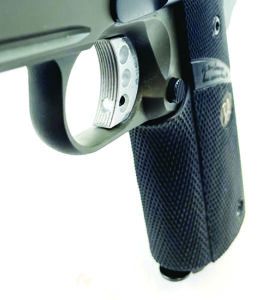
Reloading is tricky, as it is with all single-stack 1911s without a mag well funnel like on the MAC. The Springfield mag well has beveled edges, but you still need to be deliberate and concentrate when inserting a fresh mag.
The Marine comes with a soft carry case and two G.I.-style steel magazines with steel followers. The magazines worked without issue, but we prefer a magazine with a bumper pad for more sure seating when slapping the magazine home with the palm of your hand. We liked the Never Unarmed 1911 magazines better than the Springfield factory G.I. magazines.
Our Team Said: The Marine is a full-size 1911 and the closest to the MEUSOC style. The night sights, rail, and front and rear slide serrations offer modern performance. The Pachmayr grips are retro, yet we liked the feel and the grip. The cost is high, but the Marine delivers the goods with looks and performance.
| 45 ACP RANGE DATA | |||
| Hornady Critical Duty 220-grain FlexLock (+P) | Military Armament Corp. 1911 JSOC 45 | Rock Island Armory 1911 A1 Tact Standard FS Marine Corps Operator | Springfield 1911 Loaded Marine Corps Operator |
| Average Velocity | 1054 fps | 1003 fps | 1052 fps |
| Muzzle Energy | 510 ft.-lbs. | 492 ft.-lbs. | 541 ft.-lbs. |
| Smallest Group | 2.46 in. | 2.21 in. | 2.06 in. |
| Average Group | 3.35 in. | 2.60 in. | 2.26 in. |
| Armscor 230-grain FMJ | Military Armament Corp. 1911 JSOC 45 | Rock Island Armory 1911 A1 Tact Standard FS | Springfield 1911 Loaded Marine Corps Operator |
| Average Velocity | 879 fps | 828 fps | 887 fps |
| Muzzle Energy | 394 ft.-lbs. | 350 ft.-lbs. | 401 ft.-lbs. |
| Smallest Group | 2.63 in. | 2.29 in. | 1.93 in. |
| Average Group | 2.71 in. | 2.37 in. | 2.20 in. |
| Winchester Silver Tip 185-grain JHP | Military Armament Corp. 1911 JSOC 45 | Rock Island Armory 1911 A1 Tact Standard FS | Springfield 1911 Loaded Marine Corps Operator |
| Average Velocity | 991 fps | 972 fps | 994 fps |
| Muzzle Energy | 403 ft.-lbs. | 388 ft.-lbs. | 406 ft.-lbs. |
| Smallest Group | 1.34 in. | 1.49 in. | 2.77 in. |
| Average Group | 2.15 in. | 2.33 in. | 2.93 in. |
To collect accuracy data, we fired five-shot groups at 25 yards from a bench using a rest. We recorded velocities using a Garmin Zero C1 Pro chronograph.
Written and photographed by Robert Sadowski, using evaluations from Gun Tests Team members. GT


